child seat MERCEDES-BENZ G-CLASS SUV 2008 Owners Manual
[x] Cancel search | Manufacturer: MERCEDES-BENZ, Model Year: 2008, Model line: G-CLASS SUV, Model: MERCEDES-BENZ G-CLASS SUV 2008Pages: 293, PDF Size: 4.49 MB
Page 8 of 293
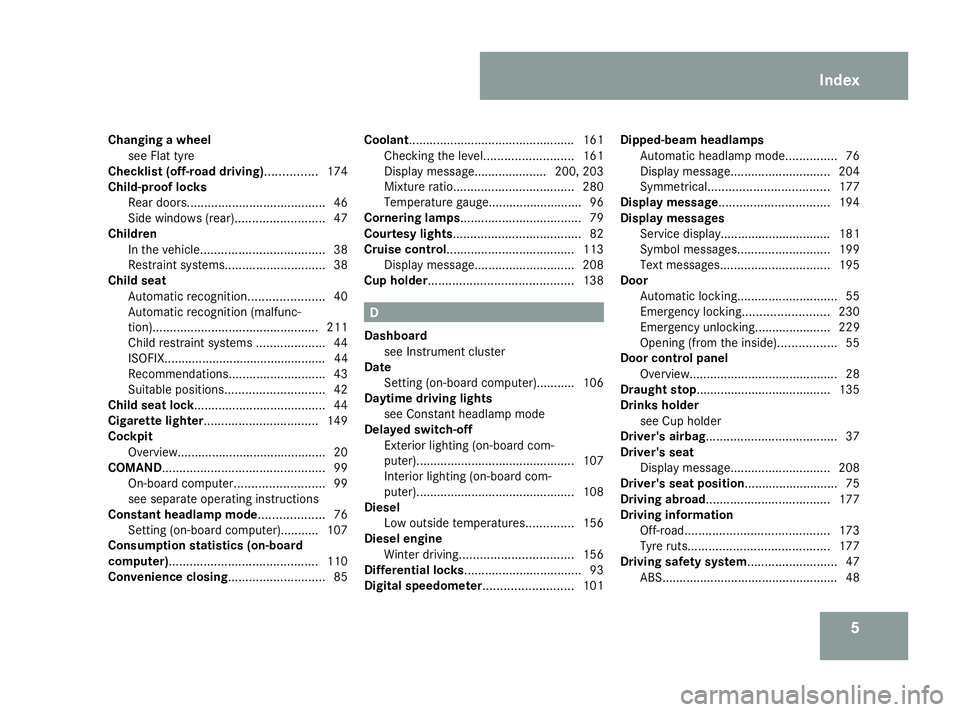
5
Changing a wheel
see Flat tyre
Checklist (off-road driving)............... 174
Child-proof locks Rear doors. ....................................... 46
Side windows (rear) ..........................47
Children
In the vehicle. ................................... 38
Restraint systems. ............................ 38
Child seat
Automatic recognition ......................40
Automatic recognition (malfunc-
tion). ............................................... 211
Child restraint systems ....................44
ISOFIX............................................... 44
Recommendations. ...........................43
Suitable positions. ............................ 42
Child seat lock...................................... 44
Cigarette lighter................................. 149
Cockpit Overview. .......................................... 20
COMAND............................................... 99
On-board computer. .........................99
see separate operating instructions
Constant headlamp mode................... 76
Setting (on-board computer).......... .107
Consumption statistics (on-board
computer)........................................... 110
Convenience closing............................ 85Coolant................................................
161
Checking the level. .........................161
Display message..................... 200, 203
Mixture ratio ................................... 280
Temperature gauge ...........................96
Cornering lamps................................... 79
Courtesy lights..................................... 82
Cruise control..................................... 113
Display message ............................. 208
Cup holder.......................................... 138 D
Dashboard see Instrument cluster
Date
Setting (on-board computer).......... .106
Daytime driving lights
see Constant headlamp mode
Delayed switch-off
Exterior lighting (on-board com-
puter). ............................................. 107
Interior lighting (on-board com-
puter). ............................................. 108
Diesel
Low outside temperatures. .............156
Diesel engine
Winter driving. ................................ 156
Differential locks.................................. 93
Digital speedometer.......................... 101Dipped-beam headlamps
Automatic headlamp mode. ..............76
Display message ............................. 204
Symmetrical. .................................. 177
Display message ................................ 194
Display messages Service display................................ 181
Symbol messages. ..........................199
Text messages. ............................... 195
Door
Automatic locking ............................. 55
Emergency locking .........................230
Emergency unlocking...................... 229
Opening (from the inside). ................55
Door control panel
Overview. .......................................... 28
Draught stop....................................... 135
Drinks holder
see Cup holder
Driver's airbag...................................... 37
Driver's seat Display message ............................. 208
Driver's seat position........................... 75
Driving abroad.................................... 177
Driving information Off-road .......................................... 173
Tyre ruts. ........................................ 177
Driving safety system.......................... 47
ABS. .................................................. 48 Index
463_AKB; 1; 8, en-GB
wobuchh,
Version: 2.10.6 2008-07-17T15:19:41+02:00 - Seite 5Dateiname: 6515_4091_02_buchblock.pdf; preflight
Page 11 of 293
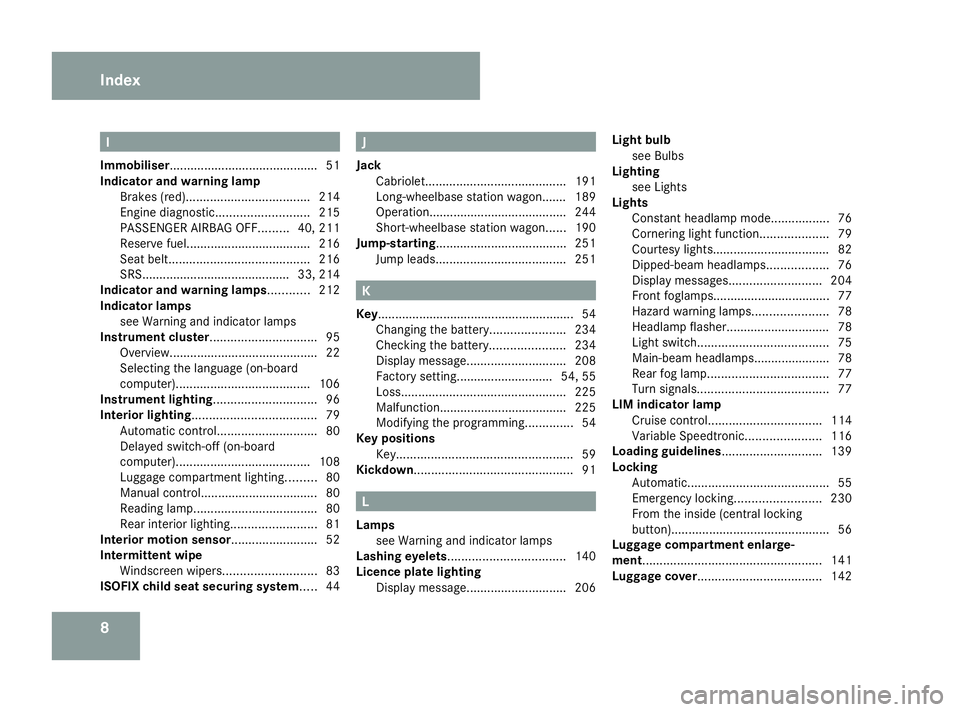
8 I
Immobiliser.......................................... .51
Indicator and warning lamp Brakes (red). ................................... 214
Engine diagnostic ........................... 215
PASSENGER AIRBAG OFF .........40, 211
Reserve fuel. ................................... 216
Seat belt. ........................................ 216
SRS........................................... 33, 214
Indicator and warning lamps............ 212
Indicator lamps see Warning and indicator lamps
Instrument cluster............................... 95
Overview. .......................................... 22
Selecting the language (on-board
computer). ...................................... 106
Instrument lighting.............................. 96
Interior lighting.................................... 79
Automatic control ............................. 80
Delayed switch-off (on-board
computer). ...................................... 108
Luggage compartment lighting. ........80
Manual control.................................. 80
Reading lamp .................................... 80
Rear interior lighting. ........................81
Interior motion sensor......................... 52
Intermittent wipe Windscreen wipers. ..........................83
ISOFIX child seat securing system..... 44 J
Jack Cabriolet. ........................................ 191
Long-wheelbase station wagon....... 189
Operation........................................ 244
Short-wheelbase station wagon. .....190
Jump-starting ...................................... 251
Jump leads ...................................... 251 K
Key......................................................... 54 Changing the battery ......................234
Checking the battery ......................234
Display message ............................. 208
Factory setting............................ 54, 55
Loss. ............................................... 225
Malfunction..................................... 225
Modifying the programming. .............54
Key positions
Key. .................................................. 59
Kickdown.............................................. 91 L
Lamps see Warning and indicator lamps
Lashing eyelets.................................. 140
Licence plate lighting Display message ............................. 206Light bulb
see Bulbs
Lighting
see Lights
Lights
Constant headlamp mode. ................76
Cornering light function ....................79
Courtesy lights.................................. 82
Dipped-beam headlamps ..................76
Display messages ........................... 204
Front foglamps.................................. 77
Hazard warning lamps. .....................78
Headlamp flasher.............................. 78
Light switch. ..................................... 75
Main-beam headlamps..................... .78
Rear fog lamp ................................... 77
Turn signals. ..................................... 77
LIM indicator lamp
Cruise control. ................................ 114
Variable Speedtronic. .....................116
Loading guidelines............................. 139
Locking Automatic. ........................................ 55
Emergency locking .........................230
From the inside (central locking
button) .............................................. 56
Luggage compartment enlarge-
ment.................................................... 141
Luggage cover.................................... 142Index
463_AKB; 1; 8, en-GB
wobuchh,
Version: 2.10.6 2008-07-17T15:19:41+02:00 - Seite 8Dateiname: 6515_4091_02_buchblock.pdf; preflight
Page 38 of 293
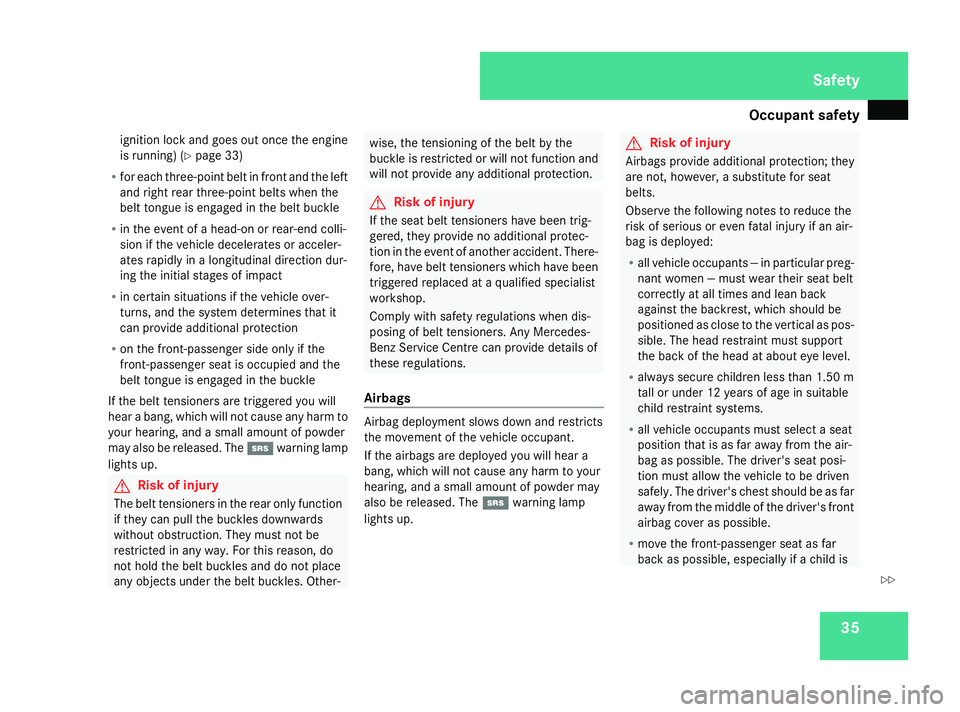
Occupant safety
35
ignition lock and goes out once the engine
is running) (Y
page 33)
R for each three-point belt in front and the left
and right rear three-point belts when the
belt tongue is engaged in the belt buckle
R in the event of a head-on or rear-end colli-
sion if the vehicle decelerates or acceler-
ates rapidly in a longitudinal direction dur-
ing the initial stages of impact
R in certain situations if the vehicle over-
turns, and the system determines that it
can provide additional protection
R on the front-passenger side only if the
front-passenger seat is occupied and the
belt tongue is engaged in the buckle
If the belt tensioners are triggered you will
hear a bang, which will not cause any harm to
your hearing, and a small amount of powder
may also be released. The 1warning lamp
lights up. G
Risk of injury
The belt tensioners in the rear only function
if they can pull the buckles downwards
without obstruction. They must not be
restricted in any way. For this reason, do
not hold the belt buckles and do not place
any objects under the belt buckles. Other- wise, the tensioning of the belt by the
buckle is restricted or will not function and
will not provide any additional protection.
G
Risk of injury
If the seat belt tensioners have been trig-
gered, they provide no additional protec-
tion in the event of another accident. There-
fore, have belt tensioners which have been
triggered replaced at a qualified specialist
workshop.
Comply with safety regulations when dis-
posing of belt tensioners. Any Mercedes-
Benz Service Centre can provide details of
these regulations.
Airbags Airbag deployment slows down and restricts
the movement of the vehicle occupant.
If the airbags are deployed you will hear a
bang, which will not cause any harm to your
hearing, and a small amount of powder may
also be released. The
1warning lamp
lights up. G
Risk of injury
Airbags provide additional protection; they
are not, however, a substitute for seat
belts.
Observe the following notes to reduce the
risk of serious or even fatal injury if an air-
bag is deployed:
R all vehicle occupants ― in particular preg-
nant women ― must wear their seat belt
correctly at all times and lean back
against the backrest, which should be
positioned as close to the vertical as pos-
sible. The head restraint must support
the back of the head at about eye level.
R always secure children less than 1.50 m
tall or under 12 years of age in suitable
child restraint systems.
R all vehicle occupants must select a seat
position that is as far away from the air-
bag as possible. The driver's seat posi-
tion must allow the vehicle to be driven
safely. The driver's chest should be as far
away from the middle of the driver's front
airbag cover as possible.
R move the front-passenger seat as far
back as possible, especially if a child is Safety
463_AKB; 1; 8, en-GB
wobuchh,
Version: 2.10.6 2008-07-17T15:19:41+02:00 - Seite 35 ZDateiname: 6515_4091_02_buchblock.pdf; preflight
Page 39 of 293
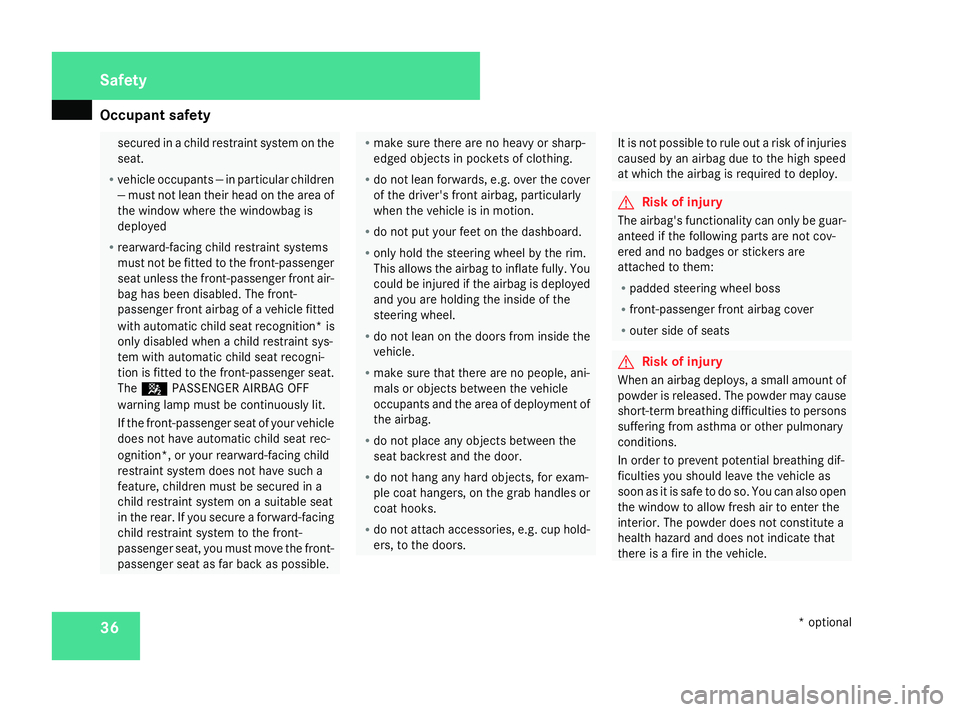
Occupant safety
36 secured in a child restraint system on the
seat.
R vehicle occupants ― in particular children
― must not lean their head on the area of
the window where the windowbag is
deployed
R rearward-facing child restraint systems
must not be fitted to the front-passenger
seat unless the front-passenger front air-
bag has been disabled. The front-
passenger front airbag of a vehicle fitted
with automatic child seat recognition* is
only disabled when a child restraint sys-
tem with automatic child seat recogni-
tion is fitted to the front-passenger seat.
The 5 PASSENGER AIRBAG OFF
warning lamp must be continuously lit.
If the front-passenger seat of your vehicle
does not have automatic child seat rec-
ognition*, or your rearward-facing child
restraint system does not have such a
feature, children must be secured in a
child restraint system on a suitable seat
in the rear. If you secure a forward-facing
child restraint system to the front-
passenger seat, you must move the front-
passenger seat as far back as possible. R
make sure there are no heavy or sharp-
edged objects in pockets of clothing.
R do not lean forwards, e.g. over the cover
of the driver's front airbag, particularly
when the vehicle is in motion.
R do not put your feet on the dashboard.
R only hold the steering wheel by the rim.
This allows the airbag to inflate fully. You
could be injured if the airbag is deployed
and you are holding the inside of the
steering wheel.
R do not lean on the doors from inside the
vehicle.
R make sure that there are no people, ani-
mals or objects between the vehicle
occupants and the area of deployment of
the airbag.
R do not place any objects between the
seat backrest and the door.
R do not hang any hard objects, for exam-
ple coat hangers, on the grab handles or
coat hooks.
R do not attach accessories, e.g. cup hold-
ers, to the doors. It is not possible to rule out a risk of injuries
caused by an airbag due to the high speed
at which the airbag is required to deploy.
G
Risk of injury
The airbag's functionality can only be guar-
anteed if the following parts are not cov-
ered and no badges or stickers are
attached to them:
R padded steering wheel boss
R front-passenger front airbag cover
R outer side of seats G
Risk of injury
When an airbag deploys, a small amount of
powder is released. The powder may cause
short-term breathing difficulties to persons
suffering from asthma or other pulmonary
conditions.
In order to prevent potential breathing dif-
ficulties you should leave the vehicle as
soon as it is safe to do so. You can also open
the window to allow fresh air to enter the
interior. The powder does not constitute a
health hazard and does not indicate that
there is a fire in the vehicle. Safety
* optional
463_AKB; 1; 8, en-GB
wobuchh,
Version: 2.10.6 2008-07-17T15:19:41+02:00 - Seite 36Dateiname: 6515_4091_02_buchblock.pdf; preflight
Page 40 of 293
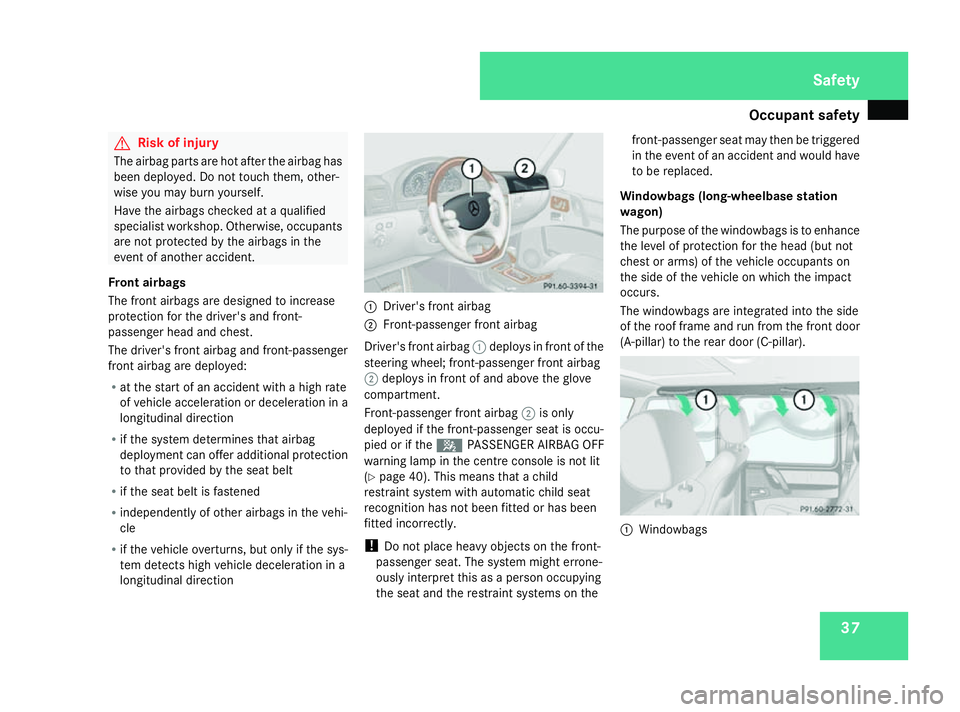
Occupant safety
37G
Risk of injury
The airbag parts are hot after the airbag has
been deployed. Do not touch them, other-
wise you may burn yourself.
Have the airbags checked at a qualified
specialist workshop. Otherwise, occupants
are not protected by the airbags in the
event of another accident.
Front airbags
The front airbags are designed to increase
protection for the driver's and front-
passenger head and chest.
The driver's front airbag and front-passenger
front airbag are deployed:
R at the start of an accident with a high rate
of vehicle acceleration or deceleration in a
longitudinal direction
R if the system determines that airbag
deployment can offer additional protection
to that provided by the seat belt
R if the seat belt is fastened
R independently of other airbags in the vehi-
cle
R if the vehicle overturns, but only if the sys-
tem detects high vehicle deceleration in a
longitudinal direction 1
Driver's front airbag
2 Front-passenger front airbag
Driver's front airbag 1deploys in front of the
steering wheel; front-passenger front airbag
2 deploys in front of and above the glove
compartment.
Front-passenger front airbag 2is only
deployed if the front-passenger seat is occu-
pied or if the 5PASSENGER AIRBAG OFF
warning lamp in the centre console is not lit
(Y page 40). This means that a child
restraint system with automatic child seat
recognition has not been fitted or has been
fitted incorrectly.
! Do not place heavy objects on the front-
passenger seat. The system might errone-
ously interpret this as a person occupying
the seat and the restraint systems on the front-passenger seat may then be triggered
in the event of an accident and would have
to be replaced.
Windowbags (long-wheelbase station
wagon)
The purpose of the windowbags is to enhance
the level of protection for the head (but not
chest or arms) of the vehicle occupants on
the side of the vehicle on which the impact
occurs.
The windowbags are integrated into the side
of the roof frame and run from the front door
(A-pillar) to the rear door (C-pillar). 1
Windowbags Safety
463_AKB; 1; 8, en-GB
wobuchh, Version: 2.10.6 2008-07-17T15:19:41+02:00 - Seite 37 ZDateiname: 6515_4091_02_buchblock.pdf; preflight
Page 41 of 293
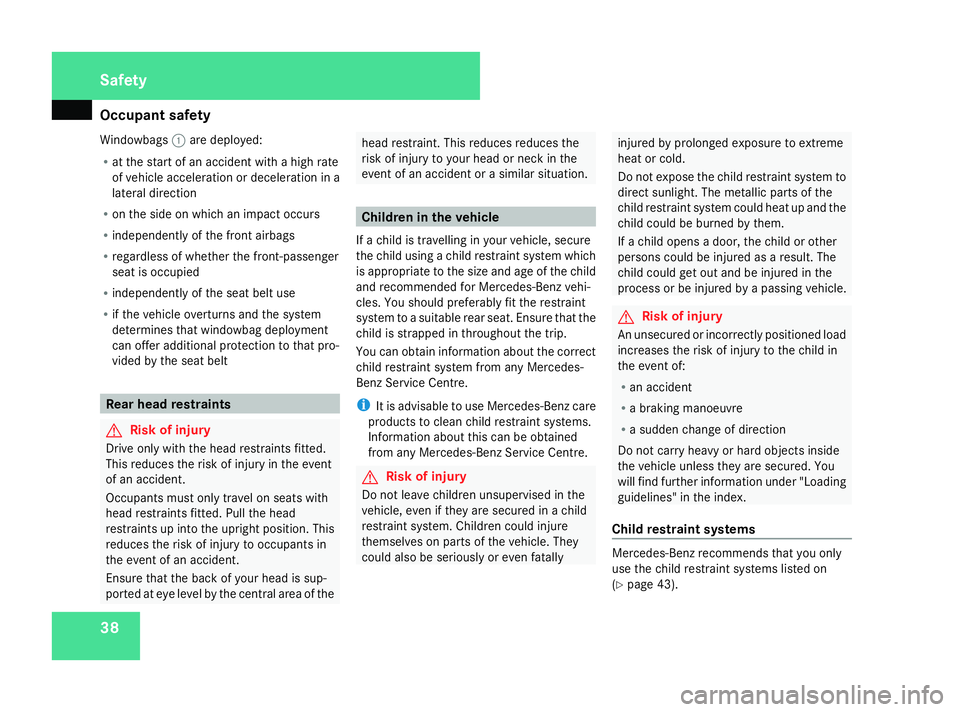
Occupant safety
38
Windowbags
1are deployed:
R at the start of an accident with a high rate
of vehicle acceleration or deceleration in a
lateral direction
R on the side on which an impact occurs
R independently of the front airbags
R regardless of whether the front-passenger
seat is occupied
R independently of the seat belt use
R if the vehicle overturns and the system
determines that windowbag deployment
can offer additional protection to that pro-
vided by the seat belt Rear head restraints
G
Risk of injury
Drive only with the head restraints fitted.
This reduces the risk of injury in the event
of an accident.
Occupants must only travel on seats with
head restraints fitted. Pull the head
restraints up into the upright position. This
reduces the risk of injury to occupants in
the event of an accident.
Ensure that the back of your head is sup-
ported at eye level by the central area of the head restraint. This reduces reduces the
risk of injury to your head or neck in the
event of an accident or a similar situation. Children in the vehicle
If a child is travelling in your vehicle, secure
the child using a child restraint system which
is appropriate to the size and age of the child
and recommended for Mercedes-Benz vehi-
cles. You should preferably fit the restraint
system to a suitable rear seat. Ensure that the
child is strapped in throughout the trip.
You can obtain information about the correct
child restraint system from any Mercedes-
Benz Service Centre.
i It is advisable to use Mercedes-Benz care
products to clean child restraint systems.
Information about this can be obtained
from any Mercedes-Benz Service Centre. G
Risk of injury
Do not leave children unsupervised in the
vehicle, even if they are secured in a child
restraint system. Children could injure
themselves on parts of the vehicle. They
could also be seriously or even fatally injured by prolonged exposure to extreme
heat or cold.
Do not expose the child restraint system to
direct sunlight. The metallic parts of the
child restraint system could heat up and the
child could be burned by them.
If a child opens a door, the child or other
persons could be injured as a result. The
child could get out and be injured in the
process or be injured by a passing vehicle. G
Risk of injury
An unsecured or incorrectly positioned load
increases the risk of injury to the child in
the event of:
R an accident
R a braking manoeuvre
R a sudden change of direction
Do not carry heavy or hard objects inside
the vehicle unless they are secured. You
will find further information under "Loading
guidelines" in the index.
Child restraint systems Mercedes-Benz recommends that you only
use the child restraint systems listed on
(Y
page 43). Safety
463_AKB; 1; 8, en-GB
wobuchh,
Version: 2.10.6 2008-07-17T15:19:41+02:00 - Seite 38Dateiname: 6515_4091_02_buchblock.pdf; preflight
Page 42 of 293
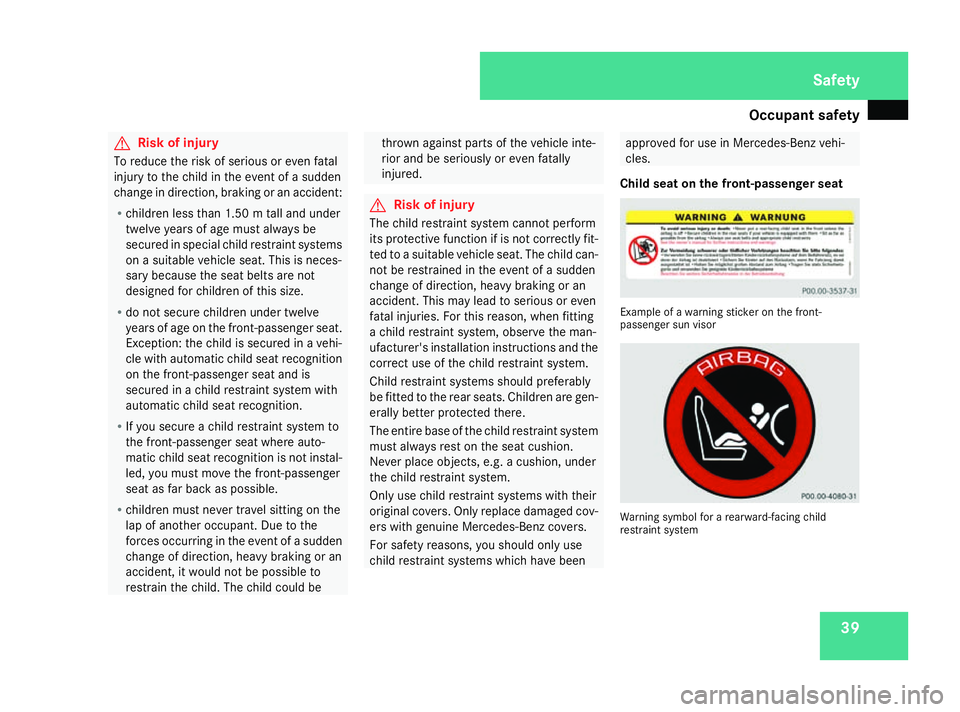
Occupant safety
39G
Risk of injury
To reduce the risk of serious or even fatal
injury to the child in the event of a sudden
change in direction, braking or an accident:
R children less than 1.50 m tall and under
twelve years of age must always be
secured in special child restraint systems
on a suitable vehicle seat. This is neces-
sary because the seat belts are not
designed for children of this size.
R do not secure children under twelve
years of age on the front-passenger seat.
Exception: the child is secured in a vehi-
cle with automatic child seat recognition
on the front-passenger seat and is
secured in a child restraint system with
automatic child seat recognition.
R If you secure a child restraint system to
the front-passenger seat where auto-
matic child seat recognition is not instal-
led, you must move the front-passenger
seat as far back as possible.
R children must never travel sitting on the
lap of another occupant. Due to the
forces occurring in the event of a sudden
change of direction, heavy braking or an
accident, it would not be possible to
restrain the child. The child could be thrown against parts of the vehicle inte-
rior and be seriously or even fatally
injured.
G
Risk of injury
The child restraint system cannot perform
its protective function if is not correctly fit-
ted to a suitable vehicle seat. The child can-
not be restrained in the event of a sudden
change of direction, heavy braking or an
accident. This may lead to serious or even
fatal injuries. For this reason, when fitting
a child restraint system, observe the man-
ufacturer's installation instructions and the
correct use of the child restraint system.
Child restraint systems should preferably
be fitted to the rear seats. Children are gen-
erally better protected there.
The entire base of the child restraint system
must always rest on the seat cushion.
Never place objects, e.g. a cushion, under
the child restraint system.
Only use child restraint systems with their
original covers. Only replace damaged cov-
ers with genuine Mercedes-Benz covers.
For safety reasons, you should only use
child restraint systems which have been approved for use in Mercedes-Benz vehi-
cles.
Child seat on the front-passenger seat Example of a warning sticker on the front-
passenger sun visor
Warning symbol for a rearward-facing child
restraint system Safety
463_AKB; 1; 8, en-GB
wobuchh,
Version: 2.10.6
2008-07-17T15:19:41+02:00 - Seite 39 ZDateiname: 6515_4091_02_buchblock.pdf; preflight
Page 43 of 293
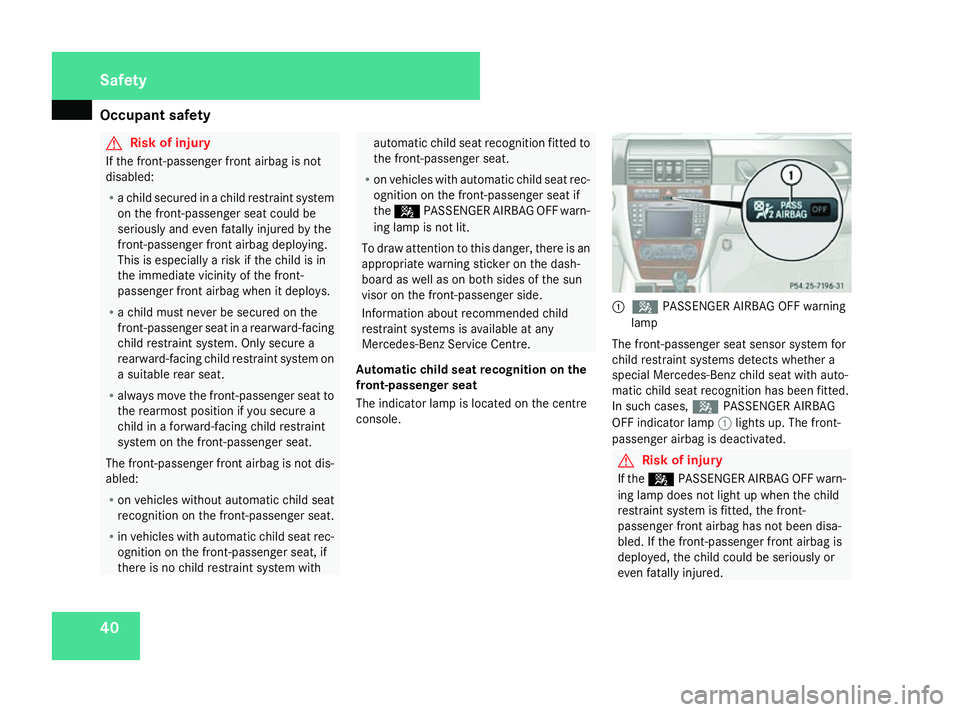
Occupant safety
40 G
Risk of injury
If the front-passenger front airbag is not
disabled:
R a child secured in a child restraint system
on the front-passenger seat could be
seriously and even fatally injured by the
front-passenger front airbag deploying.
This is especially a risk if the child is in
the immediate vicinity of the front-
passenger front airbag when it deploys.
R a child must never be secured on the
front-passenger seat in a rearward-facing
child restraint system. Only secure a
rearward-facing child restraint system on
a suitable rear seat.
R always move the front-passenger seat to
the rearmost position if you secure a
child in a forward-facing child restraint
system on the front-passenger seat.
The front-passenger front airbag is not dis-
abled:
R on vehicles without automatic child seat
recognition on the front-passenger seat.
R in vehicles with automatic child seat rec-
ognition on the front-passenger seat, if
there is no child restraint system with automatic child seat recognition fitted to
the front-passenger seat.
R on vehicles with automatic child seat rec-
ognition on the front-passenger seat if
the 5 PASSENGER AIRBAG OFF warn-
ing lamp is not lit.
To draw attention to this danger, there is an
appropriate warning sticker on the dash-
board as well as on both sides of the sun
visor on the front-passenger side.
Information about recommended child
restraint systems is available at any
Mercedes-Benz Service Centre.
Automatic child seat recognition on the
front-passenger seat
The indicator lamp is located on the centre
console. 1
5 PASSENGER AIRBAG OFF warning
lamp
The front-passenger seat sensor system for
child restraint systems detects whether a
special Mercedes-Benz child seat with auto-
matic child seat recognition has been fitted.
In such cases, 5PASSENGER AIRBAG
OFF indicator lamp 1lights up. The front-
passenger airbag is deactivated. G
Risk of injury
If the 5 PASSENGER AIRBAG OFF warn-
ing lamp does not light up when the child
restraint system is fitted, the front-
passenger front airbag has not been disa-
bled. If the front-passenger front airbag is
deployed, the child could be seriously or
even fatally injured. Safety
463_AKB; 1; 8, en-GB
wobuchh,
Version: 2.10.6 2008-07-17T15:19:41+02:00 - Seite 40Dateiname: 6515_4091_02_buchblock.pdf; preflight
Page 44 of 293
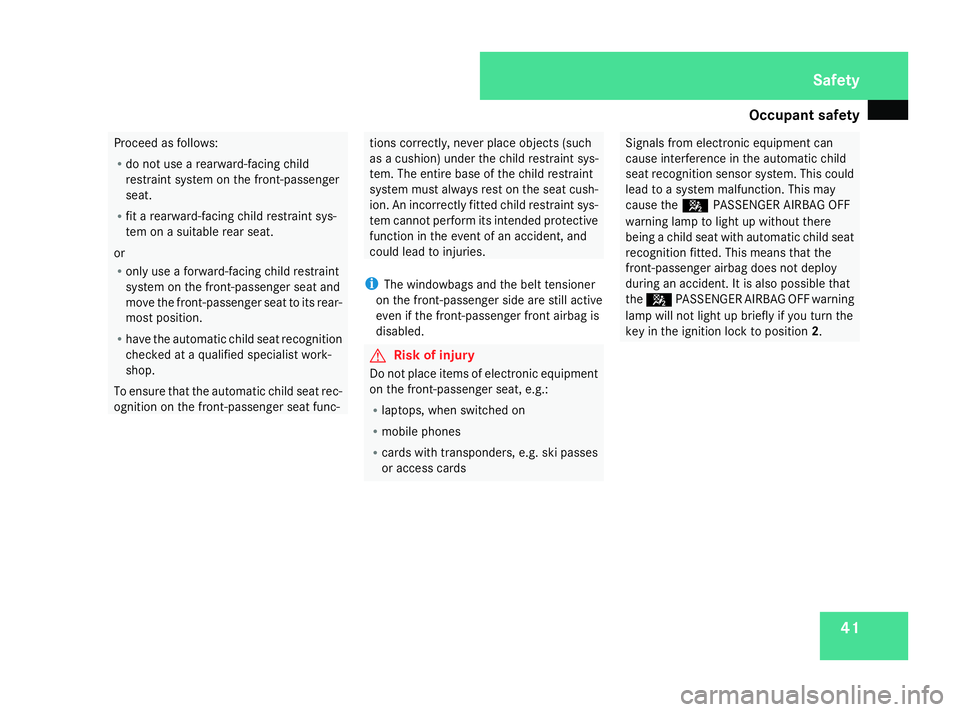
Occupant safety
41Proceed as follows:
R
do not use a rearward-facing child
restraint system on the front-passenger
seat.
R fit a rearward-facing child restraint sys-
tem on a suitable rear seat.
or
R only use a forward-facing child restraint
system on the front-passenger seat and
move the front-passenger seat to its rear-
most position.
R have the automatic child seat recognition
checked at a qualified specialist work-
shop.
To ensure that the automatic child seat rec-
ognition on the front-passenger seat func- tions correctly, never place objects (such
as a cushion) under the child restraint sys-
tem. The entire base of the child restraint
system must always rest on the seat cush-
ion. An incorrectly fitted child restraint sys-
tem cannot perform its intended protective
function in the event of an accident, and
could lead to injuries.
i The windowbags and the belt tensioner
on the front-passenger side are still active
even if the front-passenger front airbag is
disabled. G
Risk of injury
Do not place items of electronic equipment
on the front-passenger seat, e.g.:
R laptops, when switched on
R mobile phones
R cards with transponders, e.g. ski passes
or access cards Signals from electronic equipment can
cause interference in the automatic child
seat recognition sensor system. This could
lead to a system malfunction. This may
cause the
5PASSENGER AIRBAG OFF
warning lamp to light up without there
being a child seat with automatic child seat
recognition fitted. This means that the
front-passenger airbag does not deploy
during an accident. It is also possible that
the 5 PASSENGER AIRBAG OFF warning
lamp will not light up briefly if you turn the
key in the ignition lock to position 2. Safety
463_AKB; 1; 8, en-GB
wobuchh,
Version: 2.10.6 2008-07-17T15:19:41+02:00 - Seite 41 ZDateiname: 6515_4091_02_buchblock.pdf; preflight
Page 45 of 293
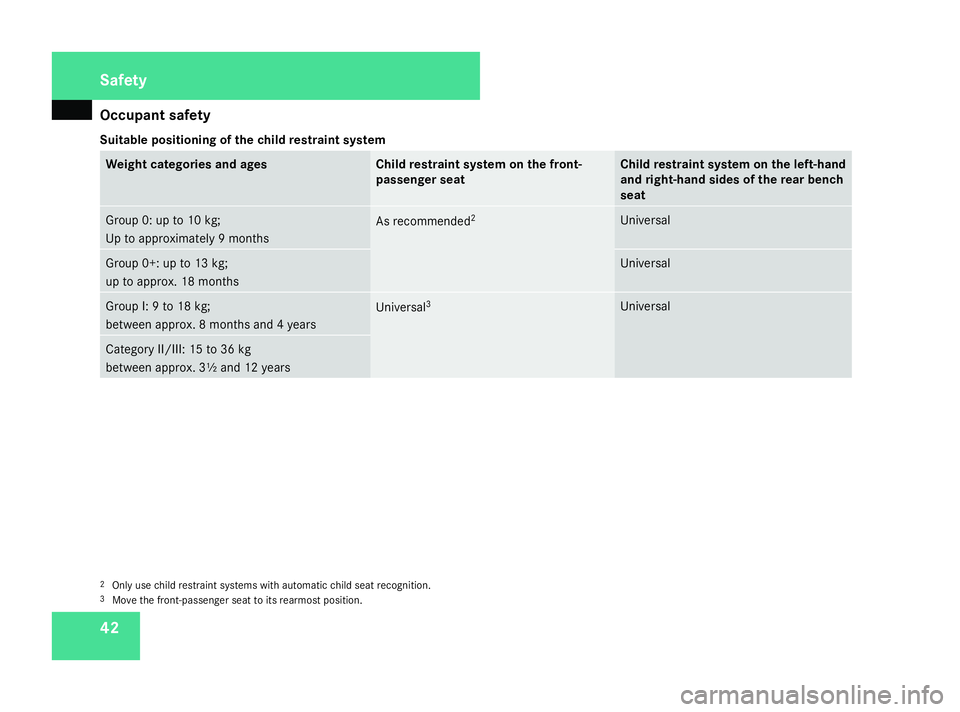
Occupant safety
42
Suitable positioning of the child restraint system Weight categories and ages Child restraint system on the front-
passenger seat Child restraint system on the left-hand
and right-hand sides of the rear bench
seat
Group 0: up to 10 kg;
Up to approximately 9 months
As recommended
2 Universal
Group 0+: up to 13 kg;
up to approx. 18 months Universal
Group I: 9 to 18 kg;
between approx. 8 months and 4 years Universal
3 Universal
Category II/III: 15 to 36 kg
between approx. 3½ and 12 years
2
Only use child restraint systems with automatic child seat recognition.
3 Move the front-passenger seat to its rearmost position. Safety
463_AKB; 1; 8, en-GB
wobuchh,
Version: 2.10.6 2008-07-17T15:19:41+02:00 - Seite 42Dateiname: 6515_4091_02_buchblock.pdf; preflight